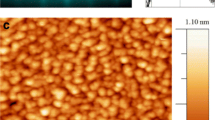Abstract
A kinetic diagram of Ge growth on Si is constructed by methods of fast electron diffraction and scanning electron microscopy. Activation energies of morphological transitions from two-dimensional to three-dimensional growth and from hut-clusters to dome-type islands are determined. The curve of the 2D–3D transition has two segments that follow the Arrhenius law and refer to different mechanisms of two-dimensional growth: two-dimensional island mechanism in the temperature range of 300–525 °C with the activation energy of −0.11 eV and step motion in the temperature range of 525–700 °C with the activation energy of 0.15 eV. Transitions from hut-islands to dome-islands are also observed. The curve constructed for the hut-dome transition is approximated by two exponential segments that obey the Arrhenius law. The hut-dome transition activation energy is 0.11 eV in the temperature range of 350–550 °C and 0.24 eV in the temperature range of 550–700 °C. The maximum density of islands in the case of Ge growth on a Ge x Si1−x layer reaches 4 · 1011 cm−2. An increase in the composition leads to an increase in the density of Ge islands owing to a decrease in the length of migration of Ge adatoms on the Ge x Si1−x surface, as compared to the case of Ge growth on Si. The periodicity N, which is manifested as a (2 × N) superstructure, decreases during the reconstruction from 14 to 8 with increasing Ge content in the Ge x Si1−x layer. An increase in thickness or temperature leads to a decrease in periodicity and testifies to Ge segregation; in this case, stress relaxation occurs, which reduces the Ge diffisivity.
Similar content being viewed by others
References
A. I. Yakimov, “Ge/Si Heterostructures with Ge Quantum Dots for Mid-Infrared Photodetectors,” Avtometriya 49(5), 57–67 (2013) [Optoelectron., Instrum. Data Process. 49 (5), 467–475 (2013)].
L. Simon, P. Louis, C. Pirri, et al., “Substrate Manipulation by Insertion of a Thin and Strained 2D Layer: Effect on Ge/Si Growth,” J. Crystal Growth 256(1–2), 1–6 (2003).
R. Butz and S. Kampers, “2×n Surface of SiGe Layers Deposited on Si(100),” Appl. Phys. Lett. 61(11), 1307–1309 (1992).
G. Jernigan and P. Thompson, “Scanning Tunneling Microscopy of SiGe Alloy Surfaces Grown on Si(100) by Molecular Beam Epitaxy,” Surf. Sci. 516(1–2), 207–215 (2002).
F. Liu, F. Wu, and M. G. Lagally, “Effect of Strain on Structure and Morphology of Ultrathin Ge Films on Si(001),” Chem. Rev. 97(4), 1045–1062 (1997).
D. B. Migas, P. Raiteri, and L. Miglio, “Evolution of the Ge/Si(001) Wetting Layer during Si Overgrowth and Crossover between Thermodynamic and Kinetic Behavior,” Phys. Rev. B 69(23), 235318 (2004).
L. W. Guo, Q. Huang, Y. K. Li, et al., “Critical Ge Concentration for a 2 × n Reconstruction Appear on GeSi Covered Si(100),” Surf. Sci. 406(1), 592–596 (1998).
D. J. Paul, “Si/SiGe Heterostructures: from Material and Physics to Devices and Circuits,” Semicond. Sci. Technol. 19(10), R75 (2004).
L. Huang, F. Liu, G.-H. Lu, and X. G. Gong, “Surface Mobility Difference between Si and Ge and its Effect on Growth of SiGe Alloy Films and Islands,” Phys. Rev. Lett. 96(1), 016103 (2006).
Author information
Authors and Affiliations
Corresponding author
Additional information
Original Russian Text © A.I. Nikiforov, V.A. Timofeev, S.A. Teys, O.P. Pchelyakov, 2014, published in Avtometriya, 2014, Vol. 50, No. 3, pp. 5–12.
About this article
Cite this article
Nikiforov, A.I., Timofeev, V.A., Teys, S.A. et al. Formation of Ge/Si and Ge/Ge x Si1−x /Si nanoheterostructures by molecular beam epitaxy. Optoelectron.Instrument.Proc. 50, 217–223 (2014). https://doi.org/10.3103/S8756699014030017
Received:
Published:
Issue Date:
DOI: https://doi.org/10.3103/S8756699014030017



